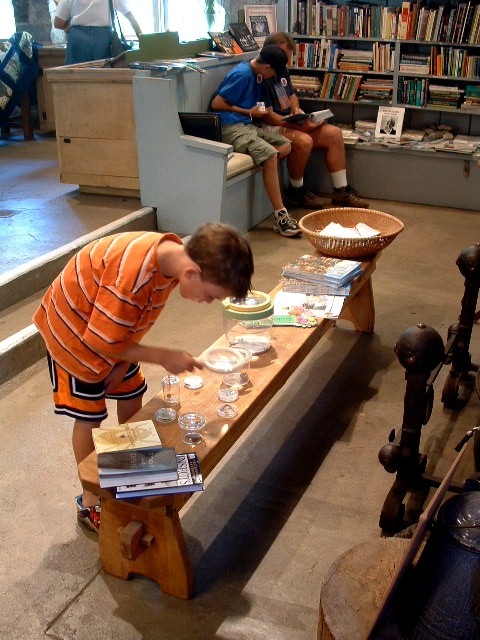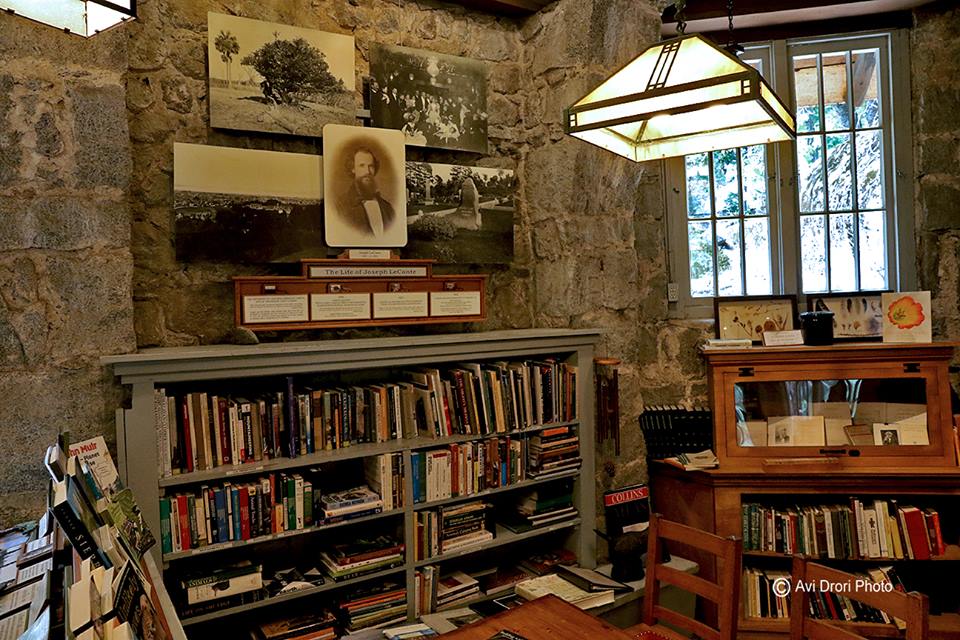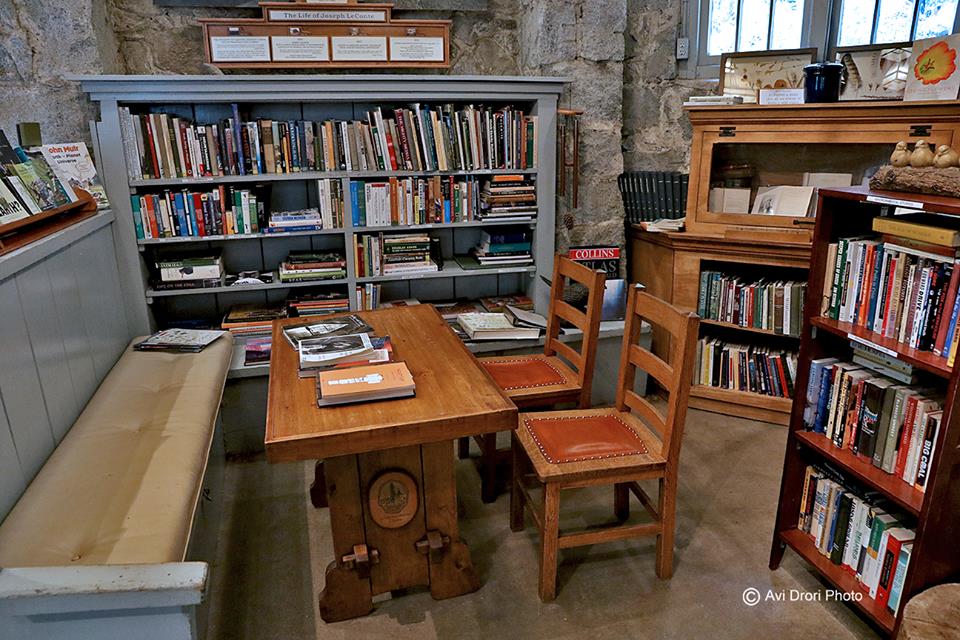
Ever since the original Yosemite Conservation Heritage Center began providing a quiet respite for visitors to Yosemite Valley in 1904, books have been an important part of the visitor experience. Before construction, in 1902 the Sierra Club's Chairman for the Committee working to establish the Memorial, Professor Andrew C. Lawson (chairman of the geology department at the University of California, Berkeley) wrote to Sierra Club members stating that it was their intention to erect "a memorial lodge to be used as a library, reading-room, and headquarters for all lovers of nature and travelers who may visit the Valley."
The library collection includes books on the natural and human history of Yosemite and the Sierra Nevada; books by and about Yosemite luminaries like John Muir, Ansel Adams, David Brower; children's nature literature; and Sierra Club books and pamphlets. All books are noncirculating, but visitors are welcome to spend as much time as they like reading the books in our library alcove. While the number of books was recorded as 55 in 1909, today there are over 2,000 volumes. The LeConte Library has since the beginning been considered a branch of the Sierra Club's main library in San Francisco (now Oakland).
Former volunteer and academic reference librarian Maryann Hight informs us further about the ongoing cultural heritage provided by the library:
"An unusually rainy season made the blazing fireplace welcome, and many lingered to get a better acquaintance with the Library."
(Report of the LeConte Memorial Committee, Sierra Club Bulletin, 1913)
The cozy scene described above evokes a traditional and sentimental image of libraries. Perusal of today's library literature, technical literature, and newspapers leads us to believe libraries are doomed because people are no longer interested in reading print books. But the library mentioned in the passage above still exists. For over 100 years, the tiny library has been informing and delighting visitors to the Yosemite Valley. The massive stone fireplace now has a small pellet stove installed to provide warmth in late spring when there is still snow in the valley, and electricity and new light fixtures have been added, but the building remains much the same as when it was built in 1903.

Photo courtesy of Avi Drori
Library History
After the building was opened, it was operated in the valley by the Sierra Club primarily as an information center for visitors, and also as a headquarters and meeting place for Sierra Club members. For many decades custodians submitted reports, published in the Sierra Club Bulletin each year. These reports varied greatly in content and style, reflecting the personality of each custodian. For example, Ansel Adams, custodian from 1920-1923, wrote narrative and chatty reports. He commented on the addition of the cables to Half Dome, gave opinions on Sierra Club outings, and noted that the park's auditorium was in poor repair.
Sierra Club reports over the years do not note whether the custodians were trained librarians, but they do indicate a dedication to the book collection. Custodians Docia Patchett and Rose Wright made the first catalog of the collection in 1917, recording a total of 350 books. Reports almost always listed the titles donated by members or purchased by the club, and frequently appealed for additional donations, as demonstrated by a 1924 report by custodian F. C. Holman:
A number of books was donated to the library and acknowledgement made by the custodian. We have now a small but well-balanced selection of books in keeping with the place. Besides those which are not allowed out of the building, there is a miscellaneous class, including science, philosophy, and fiction, that can under certain restrictions be taken away from the lodge, and this privilege, seems to be appreciated among the numerous nearby campers and people at Curry's. Even if most of the books so taken out are novels, we are filling a small want, perhaps at times exerting an influence that sometimes leads to other things. There is still shelf-room. Many of us have discarded books. Why not send in a few?

Photo by Avi Drori
Books were not the only popular items in the library collection. There is frequent mention of the popularity of maps, collections of photographs, mounted wildflower and botanical displays, a collection of polished wood, and a display of pine cones!
In the spirit of any good library, the collections grew and changed with the times. Custodian Edward Anderson reported in 1941 that in addition to natural history lectures held in the lodge, "films are shown and recorded music is played." The following year a record player and 42 recordings were donated to the library.
Custodians of the lodge and its collections also had many problems that modern-day library directors will recognize. For a time there was no water source close to the building and concerns about fire were frequently mentioned. During winter closures, rats and mice found their way into the building and to the book collections, and so rodent-proof metal boxes were installed. New locks were put on the windows after a few winter break-ins, presumably by winter campers looking for a good fireplace.
After WWII, formal reports by the custodian or information about the library and its collections were no longer published in the Sierra Club Bulletin. However in the 1970s and 1980s, the custodian and volunteers kept daily logs in notebooks, which are part of the archival material held in the collection. Frequent references are made to the library, such as this one from May 1980: "One [visitor] stayed for a few hours reading Yosemite and Its High Sierra. He started it a year ago and decided to come in and finish it this year." Alas, no journals exist for the decade of the 1990s, but the present custodian of the lodge publishes a yearly report on the web, of course!
The Library in the 21st Century
Open from May through September, this small library and information center draws over 16,000 visitors from all over the world. Some come in to ask who used to live in the quaint structure or to inquire, as one little girl did, "if Sleeping Beauty lives here." Many discover the library when they step in seeking respite from the summertime heat of the Yosemite Valley.
A popular addition is the corner of the library devoted to children's books, puzzles, and toys. The book topics range from animal ABCs to stories of the Miwok Indians, the original inhabitants of the valley. An ongoing art project in the children's corner provides a collection of drawings made by young visitors who record their impressions and experiences in Yosemite and leave their work in a series of three-ring binders for others to enjoy.
One tradition that has continued is that Sierra Club members and park visitors still donate books and materials to the library, and a few more are purchased each year with donations. This collection was expanded in 2002 and 2003 with a generous grant from a private family foundation. Topics of the books in the modern-day collection still reflect the interests of visitors to the park, including rock climbing, wildflower identification, and geology. However, topics have expanded to include global warming, recycling, and green energy.
While seemingly at odds with present-day library practices, no computers are installed in this small library, and books are informally shelved by topic. This is a studied decision by Dr. Gisel. Echoing her predecessor F. C. Holman, Gisel feels that browsing through the printed books gives visitors the opportunity for the discovery of connections between disparate ideas. "Lots of adults don't go into a library anymore," says Gisel. "They come here after years away and are linked to ideas of exploration and discovery. The library is a trigger to get people interested again."
Libraries like the one in the Yosemite Conservation Heritage Center are the carriers of our cultural heritage. Preserved here within the granite walls is part of the experience of Yosemite. It is very likely that 108 years from now visitors will find the buiding and its little library much the same as they are today, and as they were in 1904.
by Maryann Hight, Reference/Instruction Librarian, University Library, California State University Stanislaus, Turlock, California (April 10, 2012)
Ms. Hight is a regular summer volunteer at the Yosemite Conservation Heritage Center, and a strong supporter of small specialized libraries. She has written wrote a short article about the NPS libraries for publication in the journal American Libraries, November/December, 2012, including a paragraph about all three of the libraries in Yosemite.
The above text is adapted by permission from the original research paper by Maryann Hight available from Cal State Stanislaus:
Exceedingly Beautiful and Appropriate: the Library in Yosemite's LeConte Lodge